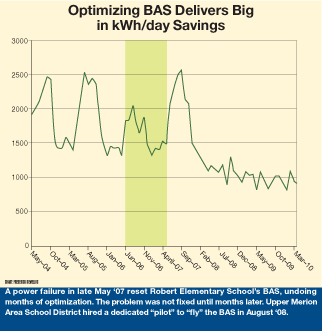Size of Automation Systems Should Be Proportionate to Building
Shorenstein Realty Services is using that technology in a portfoliowide evaluation of energy-saving strategies, says William Young, manager of engineering services in the firm's property management and construction division. Shorenstein is looking to reduce energy use by 30 percent across the 14 million-square-foot portfolio, Young says, and the firm sees its controls as the answer. With the wireless thermostats, he can now slow the fans down to what is needed in relationship to the temperature. Before the wireless solution, that approach would have been cost-prohibitive.
Another control point to consider is carbon dioxide sensors. With sensors in place, you can activate fans based on air quality instead of a clock, says Cook. "It's amazing the savings possible on a 400,000 square-foot facility with this strategy," he says.
Right Size, Right Speed
For Young, one of the main causes of energy waste is that "we're running the wrong size of equipment for too long." The EMS can play an important role in solving that problem.
He cites an acquired building where the air handlers were being shut off, but the chilled water was not in order to meet the needs of two CRAC units in a computer room. The problem was that the units needed at most 60 gallons per minute (GPM) of chilled water while the 200-horsepower pump, which was running constantly, was moving 4,000 GPM. His solution was to install a smaller pump just for those units, saving $100,000 in one year.
"Any time you're using more CFM, more GPM, than needed, you're wasting energy," says Young. "With the EMS you can now measure everything and with more controllable variables, you can slow more things down."
That's where variable frequency drives (VFDs) come in. "Systems are designed for maximums," Young says. "But when you only need 25 percent of that capacity, why are you running your system that hard?" A VFD adjusts the speed of a motor by controlling its electrical supply's frequency, allowing motor speed to match system demand.
Cook says he has found two reasons facility managers let systems run too hard for too long. First is the idea that the cost of energy can't be controlled. Second is that, in properties where the tenant pays the energy bills, energy use is a low priority for the property manager. During the due diligence for a single-tenant, one million-square-foot Class A building, Cook found it had no energy management system in place. The thought hadn't even crossed the mind of the director of engineering, Cook says, because the tenant was footing the bill. So Cook reframed the proposition in terms of slashing run time on the equipment. To an audience of skeptical engineers, he offered to cut run time on the air handlers by 54,000 hours a year, and did it by turning on the 96 air handlers at 7:15 a.m. instead of 5 a.m., he says. Coupled with a Web-based EMS and other efforts, the HVAC savings totaled 1,400,000 kWh.
Often, controls can be part of a larger upgrade project. Take for example the compounding savings achieved by Remelius in a lighting retrofit in a school gym. With the old lighting system, it took several minutes for the lights to reach full brightness, so teachers were reluctant to turn them off. Remelius swapped out the old lights for T5s with bi-level lighting, then installed motion sensors to turn the lights off when no one was present. A data logger confirmed the lights are now off 40 percent of the time, and only fully on during games, he says. The payback for the upgrade is about three to four years.

Related Topics:












